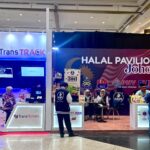Get to know Adaptive Cruise Control, a Safety System for Your Vehicle!
Posted on August 5, 2024 by Nur Wachda Mihmidati

In the modern automotive world, Adaptive Cruise Control (ACC) has become one of the most revolutionary technological innovations. This feature allows vehicles to drive smarter and safer, automatically adjusting speed to maintain a safe distance from the vehicle ahead. With ACC, you not only get added convenience on long-distance trips, but also improve your driving safety and efficiency. This article TransTRACK will discuss how Adaptive Cruise Control works, its benefits, and how this technology can make your driving experience more enjoyable and stress-free.
What is Adaptive Cruise Control?
Adaptive Cruise Control (ACC) is an advanced feature on vehicles that allows the car to automatically adjust its speed to maintain a safe distance from the vehicle ahead. ACC uses sensors, such as radar or cameras, to monitor the traffic ahead and adjust the vehicle speed according to traffic conditions.
Adaptive Cruise Control is often considered part of ADAS (Advanced Driver Assistance Systems) technology that helps improve driving safety and comfort.
Importance of Adaptive Cruise Control in Modern Vehicles
Adaptive Cruise Control (ACC) plays an important role in modern vehicles for several reasons related to driving safety, comfort, and efficiency:
Improves Safety
ACC reduces the risk of collision by automatically maintaining a safe distance from the vehicle in front. The system responds to speed changes faster than the driver. This helps prevent accidents, especially in emergency situations.
Reduces Driver Fatigue
ACC reduces the stress of long-distance driving by automating speed adjustments. Drivers can focus more on the road without having to constantly control the gas and brake. This is especially useful in traffic jams or long journeys.
Improves Fuel Efficiency
ACC keeps a constant speed for longer, reducing fuel-intensive acceleration and deceleration. Smooth speed control helps optimize fuel consumption. This is especially beneficial on highways with steady traffic flow.
Accommodating Developments in Automotive Technology
ACC is an important component in semi-autonomous vehicles, which take over some of the driving functions. It works alongside other ADAS technologies to improve safety. This integration supports the development of autonomous vehicles in the future.
Reducing the Impact of Unstable Traffic
ACC reduces the frequency of stopping and walking in heavy traffic by keeping an automatic distance. This helps reduce driver fatigue and smooth traffic flow. The system is especially effective in stop-and-go situations in urban areas.
Key Components of Adaptive Cruise Control
The main components of Adaptive Cruise Control (ACC) include several key elements that work together to detect, analyze, and control the vehicle:
Radar Sensor
Radar sensors measure the distance and speed of the vehicle ahead using radio waves. It is usually installed at the front of the vehicle, such as on the bumper. Data from the radar is used by the system to automatically adjust speed.
Camera
Cameras capture visual images to detect objects and road signs in front of the vehicle. They are often mounted near the rearview mirror or the front. This information improves the accuracy of vehicle detection and helps understand the road context.
Data Processing Unit (ECU)
The ECU analyzes data from radar sensors and cameras to make decisions about vehicle speed. Located within the vehicle’s electronic system, the ECU calculates distance and relative speed. The ECU then instructs the system to accelerate or decelerate the vehicle.
Engine and Brake Control System
This system controls the acceleration and braking of the vehicle according to instructions from the ECU. The system is found in the engine and brakes of the vehicle. This allows the vehicle to automatically adjust speed to maintain a safe distance.
Vehicle Speed Sensor
These sensors measure vehicle speed in real-time and are attached to the wheels or transmission. The speed data is sent to the ACC system. This ensures that the vehicle maintains the correct speed according to traffic conditions.
HMI (Human-Machine Interface)
The HMI provides control and information to the driver on the status of the ACC. Located on the dashboard or infotainment screen, the driver can enable or disable ACC. The HMI also displays the set speed and desired safety distance.
Adaptive Cruise Control Work Process
The working process of Adaptive Cruise Control (ACC) involves several important steps that ensure the vehicle can automatically adjust its speed and maintain a safe distance from the vehicle ahead:
System Activation by Driver
The driver activates ACC and sets the desired speed and safe distance. The system starts monitoring the vehicle speed and traffic conditions. The driver can still take control of the vehicle at any time.
Traffic Detection and Monitoring
Radar sensors and cameras detect the vehicle ahead, measuring distance and relative speed. This data is transmitted to the ECU for analysis. The system continuously monitors traffic conditions in real-time.
Data Analysis by ECU
The ECU analyzes the data from the sensors to determine whether the vehicle needs to speed up, slow down, or maintain speed. The ECU takes into account the safe distance and speed of the vehicle ahead. If necessary, the ECU will instruct the system to adjust the speed.
Speed Adjustment
The engine and brake control systems adjust the vehicle speed based on instructions from the ECU. If the vehicle ahead slows down, the vehicle automatically reduces acceleration or applies the brakes. The system maintains a safe distance automatically.
Return to Initial Speed
After the vehicle in front accelerates or changes lanes, ACC returns the vehicle to the set speed. This speed adjustment is done smoothly and safely. The system continues to monitor traffic and is ready to readjust if necessary.
System Termination
The driver can deactivate the ACC by pressing the brake, gas pedal, or a dedicated button. On some vehicles, ACC can bring the vehicle to a complete stop in heavy traffic. The driver can resume manual control or reactivate ACC after stopping.
Benefits of Adaptive Cruise Control
Here are some of the benefits of using adaptive cruise control:
Improves Driving Safety
ACC maintains a safe distance from the vehicle in front automatically, reducing the risk of collision. The system responds to speed changes faster than a human driver. This helps maintain safety in various traffic conditions.
Reduces Driver Fatigue
ACC reduces driver fatigue by automatically adjusting the vehicle speed, especially during long journeys. The driver does not need to constantly control the gas and brake. This helps reduce stress and fatigue, especially in traffic.
Fuel Efficiency
By maintaining a constant speed and avoiding sudden acceleration and deceleration, ACC improves fuel efficiency. The vehicle uses less fuel when the speed is steady. This makes ACC especially useful for highway travel.
Use of ACC in Heavy Traffic
ACC can work in heavy traffic by adjusting the speed or even stopping the vehicle completely if needed. This reduces the frequency of stopping and walking which is usually tiring for the driver. Under these conditions, ACC helps maintain comfort and reduce stress.
How to Use Adaptive Cruise Control?
How to use adaptive cruise control can be done in this way:
System Activation
Press the button or switch to activate ACC, usually located on the steering wheel or control panel. Once active, set the desired speed with the button or lever. This initiates the system to start controlling the vehicle speed.
Set Safe Distance
Select the safe distance from the vehicle in front using the buttons or levers provided. This distance can be adjusted to near, medium or far. This choice will affect how often the system changes speed.
Driving with ACC
ACC will automatically adjust the speed to maintain a safe distance from the vehicle in front. You still need to monitor the road and be ready to take over if needed. The system helps maintain speed and distance automatically.
Adjusting or Changing Settings
You can adjust the speed and safety distance at any time with the buttons on the steering wheel or control panel. This allows you to customize the settings according to traffic conditions. These changes are applied automatically by the system.
Deactivating the System
Press the disable or brake button to turn off the ACC. You can also deactivate the system with a dedicated button on the steering wheel. Once deactivated, you will control the vehicle manually.
When Coming to a Complete Stop
The ACC on some vehicles can bring the vehicle to a complete stop in heavy traffic. After stopping, you need to reactivate the ACC or control the vehicle manually. The system cannot always restart without driver intervention.
Adaptive Cruise Control (ACC) is an advanced feature that improves driving safety, reduces driver fatigue and fuel efficiency, especially in heavy traffic. With ACC, your vehicle can automatically adjust speed to maintain a safe distance from the vehicle in front, providing better comfort and handling in various road conditions. This system not only improves the driving experience, but also reduces the risk of accidents and the stress of long-distance driving.
To get the most out of ACC technology and other driver assistance systems, consider the integration of TransTRACK’s Advanced Driver Assistance System. Our ADAS offers a comprehensive solution that complements ACC with additional features such as blind spot monitoring, collision warning, and lane keeping assistance, all designed to improve your driving safety and efficiency. Contact us today to learn more about how TransTRACK ADAS can enhance your driving experience and bring innovation into your vehicle!
Topic :
 Bahasa Indonesia
Bahasa Indonesia








